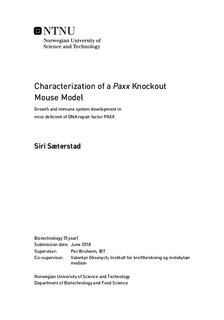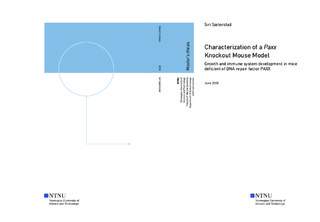| dc.description.abstract | Non-Homologous End-Joining (NHEJ) is the major DNA double-strand break (DSB) repair pathway in higher eukaryotes, functional throughout the cell cycle. NHEJ involves a variety of proteins; some are essential, whereas others are accessory factors only required for resolving specific types of lesions. Paralog of XRCC4 and XLF (PAXX) is an accessory factor that is able to interact directly with the NHEJ-determining factor Ku, and have shown to be partly redundant with the XRCC4-Like Factor (XLF). In addition, PAXX has been shown to have a significant impact on the repair of radiation- and chemically-induced DSBs in human, murine, and chicken cells, suggesting an important role of PAXX in NHEJ. However, the functional role of PAXX is still not fully understood. Isolated PAXX- and XLF-deficiencies in previously published mouse models reveal no overt phenotype, whereas a combined deficiency results in embryonic lethality due to extensive apoptosis in the central nervous system. These findings indicate important overlapping functions among these two proteins. The first aim of this project was to investigate the impact of PAXX-deficiency on growth and immune system development in our Paxx mouse model. This was done by comparing the lymphoid cell counts, spleen weight, thymus weight, and body weight of our Paxx+/- and Paxx-/- mice to WT and NHEJ-defective mice. To determine the effect of Paxx-inactivation on lymphocyte development, B and T cell frequencies in spleen and thymus of PAXX-deficient mice were compared to PAXX-proficient mice. Our Paxx knockout mouse model was here found to be indistinguishable from WT mice in relation to growth, lymphoid cell counts in thymus and femoral bone marrow, and lymphocyte development. However, a mild reduction in the number of splenocytes was observed in our Paxx knockout mice. This is suggested to be a result of impaired proliferation and/or mild defects in general DNA repair, rather than impairment of lymphocyte development. The second aim of this project was to determine whether crossing Paxx.Xlf double heterozygous mice into a p53-background could rescue the lethality of Paxx-/-Xlf-/- mice. No
Paxx-/-Xlf -/-Trp53+/- or Paxx-/-Xlf -/-Trp53-/- mice were identified among the 64 analyzed pups during this project. More mice need to be analyzed before any conclusion about viability of these complex mutants can be made. If these mice prove to be viable, this would allow in vivo studies of double-deficient PAXX and XLF mice. Further investigation of overlapping and non-overlapping functions between PAXX and XLF would enhance the current understanding of the functional interaction between these two proteins, and thus the NHEJ pathway in general. | en |

